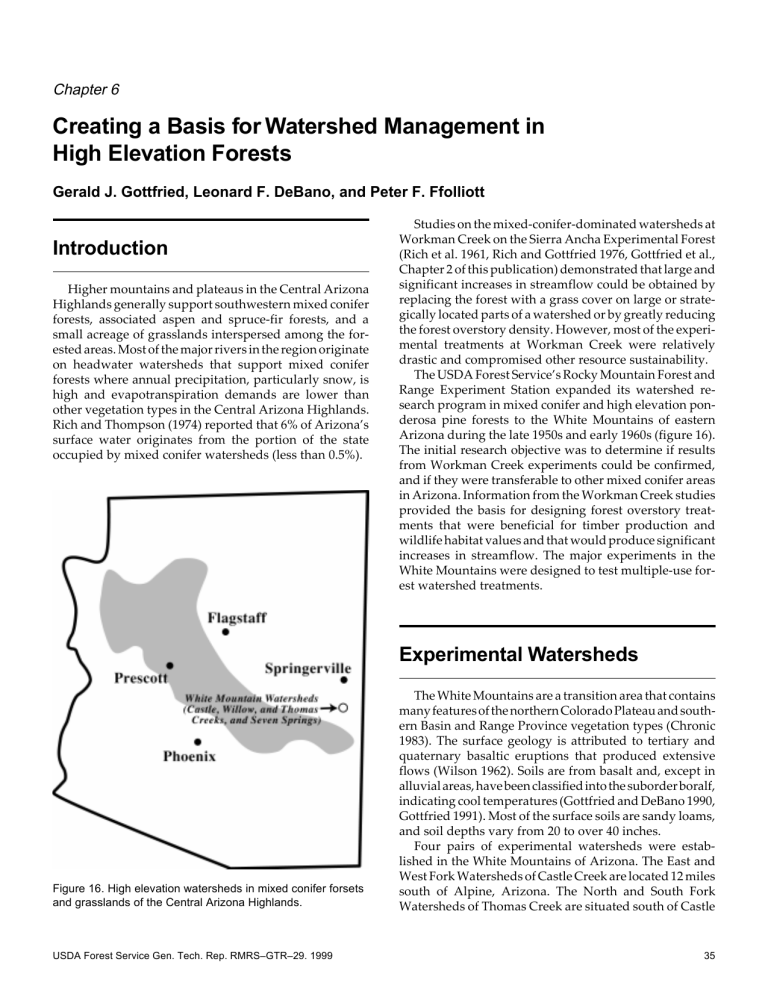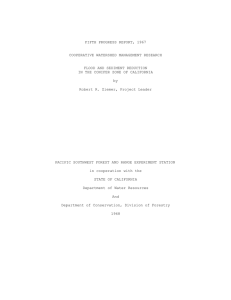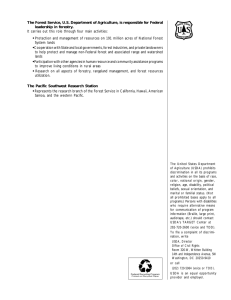Creating a Basis for Watershed Management in High Elevation Forests Chapter 6

Creating a Basis for Watershed Management in High Elevation Forests Gottfried, DeBano, and Ffolliott
Chapter 6
Creating a Basis for Watershed Management in
High Elevation Forests
Gerald J. Gottfried, Leonard F. DeBano, and Peter F. Ffolliott
Introduction
Higher mountains and plateaus in the Central Arizona
Highlands generally support southwestern mixed conifer forests, associated aspen and spruce-fir forests, and a small acreage of grasslands interspersed among the forested areas. Most of the major rivers in the region originate on headwater watersheds that support mixed conifer forests where annual precipitation, particularly snow, is high and evapotranspiration demands are lower than other vegetation types in the Central Arizona Highlands.
Rich and Thompson (1974) reported that 6% of Arizona’s surface water originates from the portion of the state occupied by mixed conifer watersheds (less than 0.5%).
Studies on the mixed-conifer-dominated watersheds at
Workman Creek on the Sierra Ancha Experimental Forest
(Rich et al. 1961, Rich and Gottfried 1976, Gottfried et al.,
Chapter 2 of this publication) demonstrated that large and significant increases in streamflow could be obtained by replacing the forest with a grass cover on large or strategically located parts of a watershed or by greatly reducing the forest overstory density. However, most of the experimental treatments at Workman Creek were relatively drastic and compromised other resource sustainability.
The USDA Forest Service’s Rocky Mountain Forest and
Range Experiment Station expanded its watershed research program in mixed conifer and high elevation ponderosa pine forests to the White Mountains of eastern
Arizona during the late 1950s and early 1960s (figure 16).
The initial research objective was to determine if results from Workman Creek experiments could be confirmed, and if they were transferable to other mixed conifer areas in Arizona. Information from the Workman Creek studies provided the basis for designing forest overstory treatments that were beneficial for timber production and wildlife habitat values and that would produce significant increases in streamflow. The major experiments in the
White Mountains were designed to test multiple-use forest watershed treatments.
Figure 16. High elevation watersheds in mixed conifer forsets and grasslands of the Central Arizona Highlands.
Experimental Watersheds
The White Mountains are a transition area that contains many features of the northern Colorado Plateau and southern Basin and Range Province vegetation types (Chronic
1983). The surface geology is attributed to tertiary and quaternary basaltic eruptions that produced extensive flows (Wilson 1962). Soils are from basalt and, except in alluvial areas, have been classified into the suborder boralf, indicating cool temperatures (Gottfried and DeBano 1990,
Gottfried 1991). Most of the surface soils are sandy loams, and soil depths vary from 20 to over 40 inches.
Four pairs of experimental watersheds were established in the White Mountains of Arizona. The East and
West Fork Watersheds of Castle Creek are located 12 miles south of Alpine, Arizona. The North and South Fork
Watersheds of Thomas Creek are situated south of Castle
USDA Forest Service Gen. Tech. Rep. RMRS–GTR–29. 1999 35
Gottfried, DeBano, and Ffolliott Creating a Basis for Watershed Management in High Elevation Forests
Creek, about 14 miles south of Alpine, and the East and
West Forks of Willow Creek are located further south near
Hannagan Meadows. A fourth set of experimental watersheds, the East and West Forks of Seven Springs, were established in the high mountain grasslands located north and east of Mt. Baldy and 11 miles south of Springerville,
Arizona. All watersheds are administered by the Apache-
Sitgreaves National Forests.
acres at elevations above 9,000 ft, and are surrounded by or interspersed with mixed conifer forests. The predominant grass species is Arizona fescue with associated mountain muhly, pine dropseed, and longtongue mutton bluegrass (Poa longiliguia) (Thompson et al. 1976). Elevations on the watersheds range from 9,200 to 9,765 ft. East Fork covers 748 acres and West Fork 482 acres.
Castle Creek
The vegetation on Castle Creek is predominately ponderosa pine with an understory of Gambel oak. Mixed conifer species occur on moist north-facing slopes and along drainages. West Fork (900 acres) and East Fork
(1,163 acres) range between 7,835 and 8,583 ft in elevation
(figure 2). Annual precipitation averaged 27 inches, and annual runoff during the calibration period averaged 2 inches on West Fork and 3 inches on East Fork.
Willow Creek
The East Fork (489 acres) watershed and the West Fork
(290 acres) control watershed on Willow Creek range between 8,800 and 9,300 ft in elevation (figure 2). The watersheds received an average annual precipitation of 34 inches (Gottfried et al. 1997). The watersheds supported an old-growth, uneven-aged southwestern mixed conifer forest consisting of Rocky Mountain Douglas-fir, Rocky
Mountain white fir, ponderosa pine, southwestern white pine, Engelmann spruce, blue spruce, corkbark fir, and quaking aspen.
Thomas Creek
The South Fork (562 acres) and North Fork (467 acres) of Thomas Creek range from 8,400 to 9,300 ft in elevation
(figure 2). The watersheds support dense mixed conifer stands that are similar in composition and structure to those on Willow Creek. Vegetation on most of the watersheds was classified as Picea engelmannii/Senecio cardamine habitat type (USDA Forest Service 1986). Annual precipitation averaged 30 inches. Annual runoff from South Fork averaged 3 inches from both South Fork and North Fork.
Seven Springs
A fourth set of experimental watersheds, the East and
West Forks of Seven Springs, were established in the high mountain grasslands. The grasslands cover about 80,000
Research Design
Castle Creek
The results from the moist-site cut on North Fork and the single-tree selection harvest on South Fork of Workman Creek indicated that even-aged management could maintain long-term timber production and improve water yields (Rich 1972). The 2 Castle Creek Watersheds, East
Fork and West Fork, were used to test this hypothesis.
In 1965, one -sixth of the area of the West Fork was harvested in irregular blocks fitted to stand conditions.
The remaining area was placed into optimum growing condition by thinning and sanitation operations (figure 17).
The idea was to duplicate commercial forest management using a 120-yr rotation and a 20-yr cutting cycle. The harvest reduced watershed basal area from 135 to 63 ft 2 / acre. Harvest blocks were planted with ponderosa pine for adequate regeneration.
A debate concerning the impacts of aggressive fire suppression on forest health and the potential dangers of stand-replacing wildfires began in the middle 1970s. Forest history studies indicate that before fire suppression, most wildfires were surface fires that reduced fuel loadings, improved seedbeds, thinned advance regeneration, and retarded the establishment of shade-tolerant species
(Dieterich 1983). Managers attempting to reintroduce fire into the region’s forests, often found it difficult because of heavy fuel buildups. Therefore, in 1981 a second watershed treatment was initiated at Castle Creek to test the effects of preharvest prescribed burning on water parameters.
The burning treatment was applied to the East Fork, which had previously served as the control watershed.
Analyses of the data indicated that this approach was valid because the streamflow annual volume relationship between West Fork and East Fork had remained constant since 1967. The fire was ignited in November 1981 and burned about 503 acres or 43% of the watershed (Gottfried and DeBano 1990). Surface fuels were consumed, while the middle forest floor layer was only slightly charred and few downed logs were totally consumed. Changes in the
36 USDA Forest Service Gen. Tech. Rep. RMRS–GTR–29. 1999
Creating a Basis for Watershed Management in High Elevation Forests Gottfried, DeBano, and Ffolliott residual stand were minimal and tree mortality was 1% of the basal area.
Willow Creek
The second test of the effects of timber management was conducted in the mixed conifer stands on the East
Fork of Willow Creek in late 1971 and 1972. The objectives of this treatment were to measure the effects of overstory removal and timber selection harvest on the quality and quantity of water yield and on other multiple use products such as timber, forage, wildlife, and recreation
(figure 18). The proposed treatment was similar to that applied to the West Fork of Castle Creek. The treatment was designed to bring the basal area level to optimum stocking primarily by removing mature, over-mature, defective, damaged, and high risk trees.
Figure 17. Thinning treatment on the
West Fork of Castle Creek.
Figure 18. Patch clearcut treatment on the East Fork of Willow Creek.
USDA Forest Service Gen. Tech. Rep. RMRS–GTR–29. 1999 37
Gottfried, DeBano, and Ffolliott Creating a Basis for Watershed Management in High Elevation Forests
Thomas Creek
Research emphasis in the mid 1970s shifted to the South and North Forks of Thomas Creek. The objective was to demonstrate and evaluate the knowledge of integrated resource management for southwestern mixed conifer forests (Gottfried 1991, Gottfried and Ffolliott 1992).
A primary objective of the harvesting treatment on
Thomas Creek was to develop an operational resource allocation plan and use a procedure to establish a management plan over a 120-yr period. Brown (1976) developed the basic allocation model. Based on inputs from managers and researchers in natural resource disciplines, a prescription using patch clearcutting with other single-tree and group selection methods was selected. They decided that this prescription would produce the highest return for a mix of timber, watershed, range, and wildlife resources. Harvesting that created small openings had been advocated by Hibbert (1979) and Rich and Thompson
(1974) as a method of increasing water yields from moist, mixed conifer forests. The Thomas Creek prescription was also consistent with the silvicultural recommendations for southwestern mixed conifer forests proposed by
Alexander (1974) and Jones (1974).
Seven Springs
The original treatment plan on the Seven Springs Watersheds was to install rows of large snow fences on one watershed to reduce the movement of snow due to wind and consequent losses of water through sublimation. Estimates based on a model developed by Schmidt (1972) predicted that this treatment could increase water yields by 1.5 to 2 inches if snow could be collected in drifts and protected from sublimation behind the snow fences. However, this plan was eliminated because of high construction expenses and concerns about the visual impact of the fences on recreationists traveling to the popular Big Lake area. The alternate plan was to create natural windbreaks by planting trees. Test plantings were conducted and initial results showed satisfactory survival but growth was very slow because of temperature-related bud damage.
A 120 o V-notch weir was used on all of the experimental watersheds in the White Mountains. Hydrologic records began at the Castle Creek Watersheds in 1955, at the
Willow Creek and the South Fork of Thomas Creek in
October 1962, at the North Fork of Thomas Creek in
October 1965, and at Seven Springs in October 1964. A weather station, including a recording precipitation gage and hygrothermograph, was established within each watershed pair; additional standard precipitation gages were also located within most watersheds. Sediment was measured in stilling basins that were constructed upstream from the weirs on all watersheds.
Snow Studies
Snow falling at the higher elevation forests is an important source of water for much of the Central Arizona
Highlands (Ffolliott et al. 1989). However, less than 10% of this water is recovered as streamflow. Snowpacks in the
Central Arizona Highlands differ from those at more northern latitudes, since extremely wet or dry winters are common and most snowpacks, except those at the highest elevations, experience some melting throughout the winter. Forest management affects snowpack accumulation and melt dynamics and can be used to increase and concentrate accumulation and to speed or retard spring snowmelt. Snowpack dynamics have been an important consideration in all of the forest watershed studies in the
Central Arizona Highlands. Watershed-level snow studies have been augmented by a large amount of research on experimental plots and sites.
Snow research efforts in the Central Arizona Highlands have focused on developing snow management guidelines for increasing the amount of recoverable water from snowpacks on forested watersheds (Ffolliott et al.
1989). Process studies in the White Mountains included the use of snow lysimeters to characterize snowmelt rates, timing of melt, and site differences in snowpack behavior under different forest canopies. Snowpack changes were linked to energy budget indices. Melt from lysimeters at
Thomas Creek was related to streamflow (Gottfried and
Ffolliott 1980). Lysimeter data in the mixed conifer forests showed that sites with low and medium stand densities had greater snowpacks, melt rates, and more runoff than denser sites.
Theoretical studies focused on the relationships between components of the solar radiation energy budget and snowmelt runoff. A number of predictive techniques and simulation models were developed from studies in the White Mountains. The SNOWMELT model, originally developed for use in the Rocky Mountains, has been adapted to conditions in the Central Arizona Highlands
(Solomon et al. 1976). Another model, YIELD, can be used to predict the effects of forest management on water yields
(Ffolliott et al. 1989). The accuracy of several snowmeltstreamflow models has been compared during this effort
(Ffolliott and Gottfried 1995).
The measurements on Thomas Creek by Plasencia
(1988) and Gottfried (1991) are examples of studies about the effects of forest management on snowpack dynamics. Similar studies have been conducted in the
38 USDA Forest Service Gen. Tech. Rep. RMRS–GTR–29. 1999
Creating a Basis for Watershed Management in High Elevation Forests Gottfried, DeBano, and Ffolliott ponderosa pine forests at Beaver Creek (Ffolliott et al.
1989).
Cooperators
The Apache-Sitgreaves National Forest was the main cooperator on the various studies in these high elevation forests. They were responsible for maintaining the hydrological and meteorological installations and assisted with several of the snow and ecological studies. In addition, the
University of Arizona cooperated with most of the studies. The Salt River Valley Users Association contributed partial financial support of the first Castle Creek treatment.
excellent conditions for deer and elk; day-use was increased (Patton 1974).
Results of prescribed fire on Castle Creek, East Fork included:
• No increase in average annual water yields
(Gottfried and DeBano 1990), which was understandable because the fire did not affect forest overstory conditions or consume much of the forest floor.
• Concentrations of NH
4
-N and NO
3
-N, PO
4
, and K increased during the first 2 post-fire snowmelt periods (Gottfried and DeBano 1990). The changes in nutrient concentrations, while statistically significant, were small and of little consequence in terms of site productivity and downstream water quality.
Results
Earlier statue-of-knowledge publications reported the results from experimental watersheds and studies conducted in the mixed conifer forest ecosystems (Rich and
Thompson 1974). Highlights of the major findings are presented below.
Castle Creek
Results from the irregular, block, harvesting treatment in predominately ponderosa pine on Castle Creek, West
Fork were:
• An annual average water yield increase of about
30%, or 0.5 inch, was attributed to reduced evapotranspiration and increased snow accumulations in the openings (Rich 1972).
• Evapotranspiration was lowered by 4 inches (19 to 15 inches) (Thompson 1974).
• Increased water yield remained stable for 21 yr
(1967 to 1987), probably because new tree roots had not fully occupied the soil mantle, and the height differences between the residual trees surrounding the openings and the regeneration continued to provide aerodynamics that favored increased snow accumulations in the openings
(Gottfried and DeBano 1990).
• Effects on wildlife were important. The mixture of forest and interspaced clearcut blocks provided
Willow Creek
Results of the diameter-limit harvest in mixed conifers on Willow Creek, East Fork were:
• Logging and wind damage caused a 68% reduction in tree density and a 82% reduction in basal area (Gottfried 1983).
• Aspen became the dominant overstory after the harvest.
• Initial logging damage to advance regeneration was severe in the diameter-limit area; there was a
71% decline in density (Gottfried 1983). Regeneration numbers and stocking were recovering 6 yr after harvest because of vigorous aspen suckering.
The heavy logging removals and wind damage compromised the original research objectives on Willow Creek,
East Fork. The diameter-limit area, before aspen dominance, was similar to a large clearcut rather than the intended stand of young sawtimber trees. The proposed openings could not be distinguished from adjacent thinned areas. Approximately 62% of the watershed was in openings (Gottfried 1991).
Evaluations of changes in runoff on Willow Creek, East
Fork indicated:
• A 54%, or 3.8 inches, increase in water yields.
• Snow water-equivalent data from a USDA Natural Resources Conservation Service (NRCS) snow course could be used to predict snowmelt runoff from a headwater drainage (Gottfried et al.
1997).
USDA Forest Service Gen. Tech. Rep. RMRS–GTR–29. 1999 39
Gottfried, DeBano, and Ffolliott Creating a Basis for Watershed Management in High Elevation Forests
The diameter-limit treatment was beneficial because:
• Deer and elk use increased in the diverse cover that provided food while retaining sufficient timber for bedding and hiding cover (Patton 1976).
• Some species, such as the yellow-bellied sap sucker, were more common in the openings than in the uncut stands, although total bird densities were reduced (Franzblau 1977).
Thomas Creek
Streamflow responses to patch cutting on Thomas Creek,
South Fork were:
• Annual water yield increased about 2 inches or
45% (Gottfried 1991). The yearly streamflow increases were generated by winter snowmelt or rain storms.
• Increases in peak flows occurred. Annual increases were about 3 ft 3 /s/mi 2 or 65%.
• Water yield increases are usually attributed to increased snowpack accumulations and reduced evapotranspiration in the forest openings
(Gottfried 1991). Snow surveys did not measure any significant changes in snow water equivalents following the harvest, although more snow was measured in the small openings than in the adjacent partially-harvested stand (Plasencia 1988).
• During high and average precipitation years, increases in water yield can occur without heavy reductions in stand density or the creation of large openings because the residual stand is unable to use all of the available water.
There was a concern that the timber harvest on South
Fork would cause accelerated soil erosion. Heede and
King (1990) determined:
• Overland flow and sediment delivery from severely disturbed and undisturbed sites were low and inconsequential. This was true even though measured sediment deliveries from severely disturbed areas (37 lbs/acre/yr) were higher than from undisturbed areas (5 lbs/ac/yr).
• Increased streamflow after treatment caused the natural channel adjustment process to accelerate, but the impacts on downstream areas were unknown.
• Mule deer, elk, and livestock benefitted from the harvested openings because of increased production of herbaceous species (Ffolliott and Gottfried
1989).
• Only minor, short-term changes in bird populations were reported (Scott and Gottfried 1983).
• Habitat requirements of red squirrels
(Tamisciurus hundsonicus) were evaluated and used in the preparation of a marking guide to minimize detrimental affects from timber cutting (Patton and Vahle 1986, Vahle and Patton
1983).
Ecologically-oriented studies were also conducted on the Thomas Creek areas before treatment. A study by
Dieterich (1983), described the fire history in this mixed conifer stand. Dieterich found that before 1900, fires burned through South Fork at intervals of 22 yr and that small, localized fires occurred frequently throughout the area. Fire suppression resulted in changes in stand structure and composition, a greater number of smaller trees, and more shade-tolerant species that normally would have been reduced by periodic ground fires.
Other studies conducted on Thomas Creek and Willow
Creek were used to characterize dwarf mistletoe infections by host, site, and stand characteristics (Gottfried and Embry 1977) and to describe species and stand growth of an old-growth mixed conifer forest (Gottfried
1978).
Studies were also initiated during preparation of or immediately after the harvest. Determination of the effects of treatment on forest productivity and sustainability was based on common stand parameters such as species composition, stand structure and stocking, regeneration success, and growth of residual trees and stands
(Gottfried and Ffolliott 1992). The Thomas Creek treatment produced a wide range of benefits while retaining many desired old-growth stand characteristics.
Seven Springs
Climatic data from Seven Springs (grassland) and the nearby station at Burro Mountain, within a mixed conifer stand, were compared to determine feasibility of using windbreaks in these grassland sites. Soils analyses indicated that the main difference between forest and grassland soils was the lack of mycorrhizae in the grassland soils (Thompson et al. 1976). Temperature data from Seven
Springs and Burro Mountain Station were similar. Annual precipitation at Seven Springs averaged 22 inches while
Burro Mountain averaged 32 inches, but high winds on the grasslands may have resulted in inaccurate gage readings. Thompson and his associates (1976) believed that lower available soil water, related to snowpack sublimation, was one reason that trees had not moved into the grasslands. Trees are found at the edges of the grasslands where topography shelters them and the snowpack from wind; moderating the microclimate.
40 USDA Forest Service Gen. Tech. Rep. RMRS–GTR–29. 1999
Creating a Basis for Watershed Management in High Elevation Forests Gottfried, DeBano, and Ffolliott
Implications
Research results from the experimental watersheds in the White Mountains of Arizona have increased the knowledge about hydrology and watershed management of mixed conifer and high elevation ponderosa pine forests in the Central Arizona Highlands, and to some extent, of the high elevation grasslands. Watershed treatments were directed towards practical options that would be useful to forest managers. This is demonstrated by:
• The shift in opening size, from large openings dominated with seeded grasses on the North Fork of Workman Creek (Rich and Gottfried 1976), to smaller 20 acre openings on Castle Creek where tree regeneration was the goal. The small 1 to 2 acre openings on the South Fork of Thomas Creek were the next step in achieving forest regeneration while increasing runoff by increasing snow accumulations and lowering evapotranspiration demands. The shift in size also reflects concerns about forest esthetics. The change from evenaged to uneven-aged silviculture in the residual stands also reflects this change.
• The initial emphasis of the watershed management research program was to determine how to increase runoff into the Salt River System. Management for other forest resources, especially timber and wildlife, was of secondary importance in the 1950s. However, management for water at the expense of the forest was unacceptable.
• Water-yield augmentation is no longer a primary management goal in the Central Arizona Highlands. Even timber production has declined as other forest value, such as recreation and concerns about rare and endangered species, have increased.
Current Status
Most of the watershed experiments were terminated between 1983 and 1986. However, the Apache-Sitgreaves
National Forest continues to collect streamflow and precipitation measurements from the Castle, Willow, and
Thomas Creek Watersheds as part of its hydrological monitoring program. Vegetation transects and points continue to be visited by USDA forest pathologists to determine changes in dwarf mistletoe infections over time.
Additional inventories are being considered by scientists at the Rocky Mountain Research Station. Data from the watersheds have also been used by graduate students at the University of Arizona.
USDA Forest Service Gen. Tech. Rep. RMRS–GTR–29. 1999 41
Gottfried, DeBano, and Ffolliott Creating a Basis for Watershed Management in High Elevation Forests
42 USDA Forest Service Gen. Tech. Rep. RMRS–GTR–29. 1999






